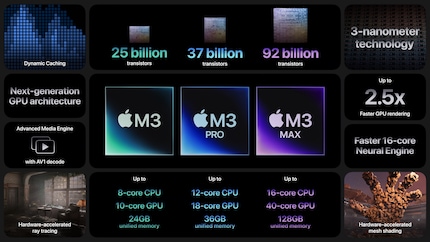
News + Trends
New MacBook Pro, new iMac: Apple unveils devices with M3 chips
by Samuel Buchmann

The new Mac chips are graded differently to their predecessors and some cost more. This is likely down to production issues.
At the beginning of the week, Apple launched new Mac chips. The M3 series is striking in several aspects. It’s right at the limit of what is currently technically feasible. This has positive and negative effects – and redefines the meaning of Normal, Pro and Max.
The most significant innovation of the M3 series is that its chips are the first to have been manufactured using the 3-nanometre process. This means smaller individual transistors, which enables denser chips. However, production is a big challenge. More on that shortly.
Smaller transistors make the cores of M3, M3 Pro and M3 Max faster without requiring more energy. According to Apple, there’s a CPU performance increase of 15 per cent for the performance cores and 30 per cent for the efficiency cores. In addition, Apple has kitted out the graphics processor with some new tricks: dynamic caching, mesh shading and ray tracing.
The number of cores and the size and bandwidth of the unified memory have also changed depending on the chip version. Read on for an overview below, including a comparison to the M2 series.
Like most major manufacturers, Apple has its chips manufactured by TSMC. The Taiwanese company has been able to further reduce the size of its transistors over the last few years. Intel – the second next-largest chip manufacturer – has been struggling with this so far.

But not everything is going to plan at TSMC either. M3 chips are based on the first 3-nanometre manufacturing process, called N3B. Apparently, there are efficiency problems when it comes to production: the yield is smaller than expected. This means that many chips have defects, meaning that they either fail or only partially pass quality control.
To ensure that all of these chips aren’t completely lost, chip manufacturers sell so-called binned versions. Where Apple’s concerned, these are chips where most of the cores are completely fine, but a few aren’t. The defective cores are deactivated and Apple sells the chips as cheaper versions. In the M3 series, this means:
This increase in production efficiency is nothing new. There were binned chips in the M1 and M2 series. But this year, part of the CPU on the weaker M3 Max will also be deactivated and the bandwidth of the unified memory lowered. The latter also applies to the M3 Pro. Apple has also replaced two performance cores in the middle chip with the less problematic efficiency cores.
Apple has reportedly bought up TSMC’s entire N3B production capacity. Nevertheless, the factories are said to be running at their limits. The high-end M3 Max with its full 16 CPU cores and 40 GPU cores is particularly problematic. To counteract this, Apple is increasing the prices of the Max and lowering them on the Pro. This shifts the focus of demand towards the more readily available chips.
The graphic below shows the prices of the M3 series compared to the M2 series. They each apply to the 14-inch MacBook Pro with 1 TB SSD and the basic RAM of the chips. The prices in US dollars are particularly relevant to illustrate Apple’s pricing policy. Exchange rates apply to other currencies. The second and third slides show the prices in Swiss francs and euros.
The price jump from 14 to 16 inches is now 300 dollars in the USA. It was still 200 dollars with the M2 chips. This could also be a measure to balance demand and production, increasing the incentive to buy small laptops, where the Max chip is probably a less popular option. In Switzerland, the surcharge for the larger screen remains almost the same: 230 francs instead of the previous 220. In Germany, it’s 250 euros rather than 230.
The changes in chip design mean that a rethink is required. M3, M3 Pro and M3 Max are graded differently to their predecessors. Only benchmarks will provide certainty. However, we can speculate based on the specifications:
The new chips mean that Apple is diversifying its range. The gap between the M3 at the bottom and the M3 Max at the top is increasing. In the middle, the M3 Pro drops lower, closer to the M3.

The M3 series is also a hidden price increase. Typically, new generation devices cost the same as the old ones, but have more performance. This time, the M3 Max is more advanced, but is also more expensive than the M2 Max. The M3 Pro remains about the same price as the M2 Pro, but probably won’t be any faster.
Does this make the new MacBook Pros a bad update? No. They just divide the target groups more clearly. If you’re considering a purchase and definitely want to order now, I’d rate them as follows:
It’s best to be patient and wait to see whether the predictions are right. Because there are still question marks about multiple things: how much of an advantage is dynamic caching? How much of an impact does the smaller memory bandwidth have on the M3 Pro and the binned M3 Max? How much more energy efficient are the 3-nanometre chips? The answers will be in our detailed test report, which will be available to read here soon.
Header image: Apple Keynote screenshot
My fingerprint often changes so drastically that my MacBook doesn't recognise it anymore. The reason? If I'm not clinging to a monitor or camera, I'm probably clinging to a rockface by the tips of my fingers.
Interesting facts about products, behind-the-scenes looks at manufacturers and deep-dives on interesting people.
Show all